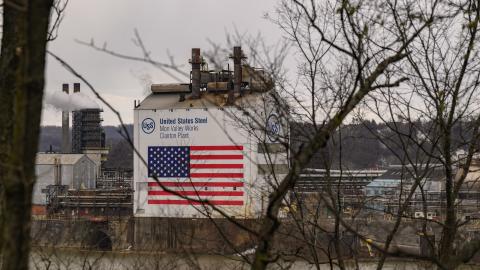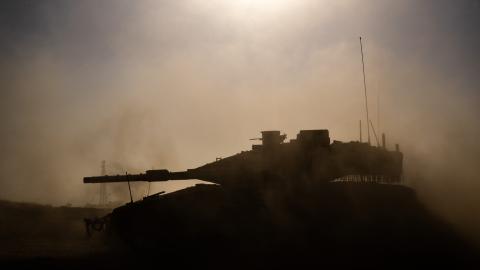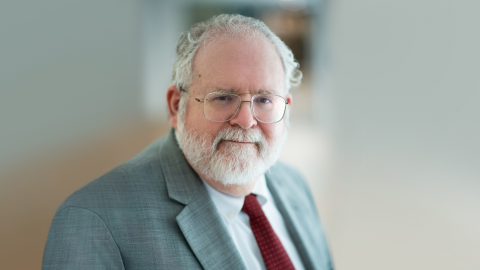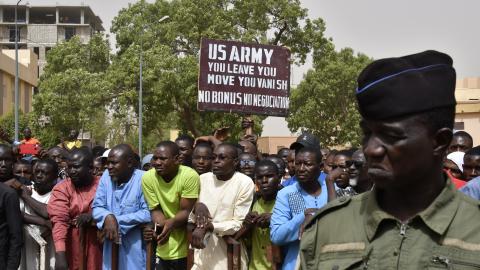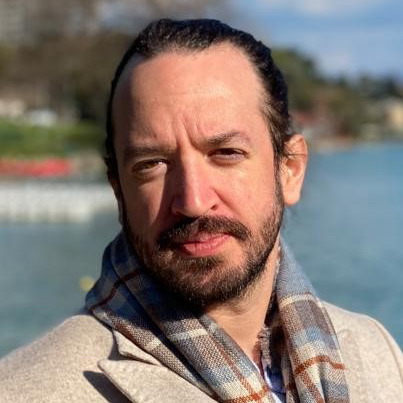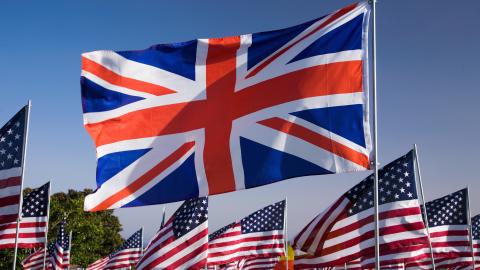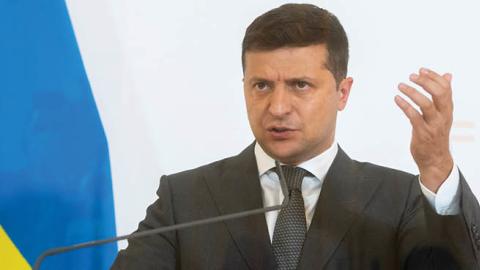In April, over one hundred thousand Russian troops amassed along Russia’s border with Ukraine. What was that about? Some believe it was a reconnaissance mission. A test of world reaction, particularly in Europe and the new American administration. Others point to the build-up’s presence of landing craft, field hospitals, blood banks, and refugee camps, and believe this was no test, but rather real preparation for an invasion. In that view, the threat remains chillingly real as only about five percent of the Russian build-up has been removed.
This lack of clarity regarding Russia’s near-term intentions parallels confusion in the West about Ukraine generally. Some view Ukraine as within Russia’s sphere of influence, not vital to American interests, and better left alone. Others view the seven-year-old Russo-Ukrainian War as a clash of civilizations with considerable moral and geopolitical stakes for America and the West.
The American political spectrum is similarly divided, sometimes in unusual combinations. In their own ways, both Thomas Friedman on the Left and Patrick Buchanan on the Right have long written sympathetically of Russian perspectives. And yet, in a deeply divided Congress, overwhelming bipartisan majorities support robust military and development assistance for Ukraine, reflecting what passes for legislative consensus these days.
The Trump Administration’s actions in Ukraine also reflected these alternating conceptions.
Through one lens, one sees ambivalence. President Trump’s respectful – at times even jarringly pleasant – disposition toward Russian President Vladimir Putin contributed to a perception that Ukraine was not a high priority to the American government. The first Trump impeachment cast a darker shadow on the president’s interests in Ukraine, suggesting a linkage between American aid and domestic political concerns.
Through another lens, however, the media narrative of President Trump as a Russian puppet is grossly false. Trump adopted three policies that were exceptionally important to Ukraine in its conflict with Russia. That Trump would risk his courtship of Putin by supporting Ukraine lends credence to the belief that American vital interests are indeed at stake.
First, Trump maintained U.S. sanctions on Russia that had been imposed by the Obama administration following Russia’s annexation of Ukrainian territory in Crimea and occupation of Ukraine’s eastern Donbas region in 2014. As Trump entered office in 2017, many speculated that he would lift those sanctions. Just thirteen days into office, however, his administration announced at the United Nations that sanctions against Russia would remain in place until it returned control of all Ukrainian territory.
In fact, Trump robustly expanded Russian sanctions, including first-ever individual sanctions on key Russian oligarchs with close ties to Putin and major corrupt dealings in Ukraine.
Second, Trump reversed Obama’s policy against lethal military aid to Ukraine. In 2017, he approved the sale of Javelin anti-tank missiles. In a recent meeting with top Ukrainian military leaders, I asked how often the Javelins have been used and what impact they’ve had. The answers were “never” and “tremendous.”
They explained that the sale of Javelins drastically changed the picture for Russia. It was a powerful symbol of American commitment to Ukraine. It also had immense deterrence value. They estimate that the existence of the Javelins caused Russia to contemplate the need for three times more tanks to accomplish its goals in Ukraine. Raising the Russian cost of invasion makes it less likely to happen.
Third, President Trump was a strident opponent of the Nord Stream 2 gas pipeline between Russia and Germany. Stopping the pipeline is critically important to Ukraine financially and militarily. The financial implications are well-known. Since the 1960s, Ukraine has been the principal conduit for Russian natural gas into Europe. Nord Stream 2 would eliminate the need for the trans-Ukraine pipeline and a major source of Ukrainian revenue. Less well observed are the strategic implications. Without Nord Stream 2, a land war in Ukraine would threaten a major gas disruption for Europe. With Nord Stream 2, Russia has a freer hand to invade.
President Trump viscerally opposed the pipeline. He complained loudly and frequently about the irony that while Germany urgently values America’s NATO commitment to the defense of Europe against Russian aggression, it is engaged in a project that will enrich Russia and promote European energy dependence on the Kremlin. Trump and Ukraine’s views on Nord Stream 2 could not have been more aligned.
As he takes over the reins of U.S. foreign policy, President Biden is off to an uneven start toward Ukraine. He has proclaimed America’s commitment to Ukraine’s territorial integrity, and he appears determined to continue the Trump position on weapons sales, rather than reverting to Obama’s prohibition. However, Biden recently reversed course on Nord Stream 2 related sanctions, thereby promoting Russian interests at Ukraine’s expense. And at the Geneva Summit with Putin in June, Biden soft-pedaled the Ukraine issue, embracing the Minsk Agreement framework, which would resolve the crisis on terms favorable to Russia.
The Moral Case
As the Soviet Union was collapsing in late 1991, Ukraine held a referendum in which ninety percent of its people voted in favor of independence. Every Ukrainian region favored it. The areas with the greatest affinity for Russia – areas now illegally occupied by Russia – voted in favor of independence by 84% (Donetsk), 84% (Luhansk), and 54% (Crimea).
At the time of independence, Ukrainian territory contained so many Soviet nuclear weapons that it would have been the world’s third-largest nuclear state had it not agreed to relinquish them. In the 1994 Budapest Memorandum, Ukraine, the United States, the United Kingdom, and Russia agreed on two things: Ukraine gave up all nuclear weapons, and the other signatories pledged to respect and guarantee Ukraine’s borders and territorial integrity. As the U.S. and U.K. had no designs on Ukrainian territory, the Budapest Memorandum’s guarantees were clearly intended to bar a future resurgent Russia from seeking to reclaim its lost empire.
In its first three decades as a free country, democratic Ukraine proceeded with a series of national elections. Some resulted in western-oriented governments, others in governments more favorably disposed toward Russia. In 2008, the Ukrainian government sought membership in NATO. President Bush supported it, but the move was rejected by France and Germany. Ukraine remained outside the NATO security umbrella.
In 2008, both European and Ukrainian public opinion was divided on the NATO question. In 2014, following the Russian occupation of seven percent of Ukrainian territory, several things changed.
More than 13,000 Ukrainians have been killed in the war, over a quarter of them civilians. The Russian aggression was met with a strong Western reaction including heavy sanctions that remain in place seven years later. The Ukrainian government is more pro-West and pro-America today than ever before. And most importantly, the Ukrainian public has turned massively against Russia. It overwhelmingly sees its future as aligned with the West. It sees its conflict with Russia as a central battle in a clash between sovereign free peoples and authoritarian foreign dominion.
Ukrainians still have what many Americans today might consider a romantic vision of our country. They see America as the leader of the free world, and their own fate largely tied to America. They firmly believe that American moves to date have prevented further Russian aggression and have not left them to fight Russia alone. In its capital city, Ukrainians are building a monument to President Reagan where a Communist monument once stood.
Yet at the same time, they feel unprotected and under-loved. In their worldview, despite facing enormous danger and ongoing military attacks, they chose democracy and the West, gave up their nuclear weapons, had some of their territory forcibly robbed from them, and they are still not fully embraced by the West.
The Geopolitical Case
America has never conducted its foreign policy solely based on idealistic or moral grounds. Further, it has had some decidedly unsatisfying experiences with the Wilsonian ideal of making the world safe for democracy. When looking at Ukraine, the question is whether there’s more at stake than our natural impulse to help good guys defeat bad guys.
There is also an increasing consensus that China is the largest geopolitical threat facing America and the free world today. Some argue that Russia, with an economy smaller than Canada’s, poses no major threat to U.S. security. Focus, they say, must be placed squarely on China. Distractions, whether from the Middle East or Eastern Europe, are unwelcomed and counterproductive.
This view misses a few important things about Russia. It might be correct that a benign Russia, or even an internally repressive Russia that keeps to itself, is of little consequence to U.S. interests. That is not Vladimir Putin’s Russia.
While Russia poses considerably less of a long-term threat than China, it is more than a mere nuisance. From Iran to Venezuela, from Syria to Cuba, from election interference to increasingly aggressive cybercrimes, Putin’s Russia actively undermines U.S. interests around the world and on our own shores. Its spy agencies routinely eavesdrop on American officials, break into our computer systems, and recruit American personnel. Its military has more nuclear weapons aimed at the American homeland than any country in the world. It is presently increasing its strategic capabilities and attempting to overcome our own. There is nothing benign about today’s government in Moscow.
Eastern Europe and the Caucusus are the central theatres of Russian aggression. Georgia, Armenia, Belarus, Moldova, and Ukraine — all former Soviet Republics — have all either lost territory to or largely ceded government control to Russia during Putin’s reign. Putin’s vision is the renewal of the former Russian empire by coercion if possible and by force if necessary. Among those territories, Ukraine is most critical to the Russian vision. Its loss to the West would be the biggest blow.
Russian activity in Ukraine should be viewed in this context. If Slavic and Orthodox Christian Ukraine becomes a normal successful democratic and western-oriented country, the renewal of the Russian empire is impossible. Further, just as the Soviet empire unraveled quickly from 1989-91, a fully free Ukraine could lead to a fully free Moldova, Belarus, and Georgia, completing the process that began thirty years ago. Should that happen, the Putin regime itself would be in serious jeopardy, just as Tsarist Russia and the USSR collapsed. A student of history, Putin’s conduct suggests he has drawn this conclusion himself.
Given Russia’s worldwide disposition toward U.S. interests, the geopolitical benefits of a free and intact Ukraine are manifest.
In or Out?
In international relations, the behavior of countries nearest the frontlines of conflict is often more instructive than those at safer distances.
Opponents of the Iran nuclear deal, for example, point to the fact that the countries most threatened by Iranian aggression were most notably absent from the agreement. Proximity to Iran, and greater familiarity with its government’s ways, produce heightened alarm.
So too with Russia. The countries nearest Russia understand its dangers more acutely than others. Among NATO countries, the Baltic States, Poland, and Romania are most highly supportive of Ukrainian NATO membership. Such membership, however, presents a host of complicating factors, not least the opposition by some Western European countries. It is instructive though, that while non-NATO Ukraine, Moldova, and Georgia have been subjected to Russian military attacks, formerly Soviet Lithuania, Latvia, and Estonia have not. It is surely not that Russia has less design on its former Baltic territory. It is NATO membership that has stood in its way. That is precisely why Ukraine is eager to join NATO, and why Putin strenuously opposes it.
Should NATO membership not materialize, however, there are several other steps that would also bolster Ukrainian security. Designation as a Major non-NATO Ally, akin to U.S.-friendly countries as disparate as New Zealand, Brazil, and Morocco, would codify a U.S.-Ukrainian strategic relationship and provide Ukraine with significant new military and financial advantages.
Or simply greater military cooperation would provide major benefits. After the recent Russian buildup, British ships entered the Black Sea in a show of support for Ukraine. This was eye-opening for Russia. Expanding U.S. weapons sales to include air defense, anti-drone, and anti-sniper equipment would boost deterrence by raising Russian costs just as the Javelin sale did.
Conversely, inaction is no less a choice than action.
Ukrainian leaders believe Russia wants to control Ukraine at the lowest possible cost to itself. In this view, Russia would return the occupied Donbas if Ukraine accepted a federalized system in which its eastern territory returns on Russian terms and Ukraine stops its moves toward the West. This is essentially the Minsk formulation that Biden appeared to embrace at the summit with Putin.
However, this Russian vision is less likely now than ever. Ukraine is very different today than it was in 2014. It is now stronger and more unified against Russia. Its morale is high. It has a significant measure of international support. It is taking unprecedented steps against the Russian-allied oligarchs who have bred corruption throughout Ukraine’s economy and governance. In short, Russia is quickly losing its ability to influence events politically, culturally, and economically in Ukraine.
That leaves Russia with only a military option to achieve its goals. But Ukrainian and western actions have raised the cost of that decision. In an expanded conflict, Ukraine would fight, and it would fight with a better trained and equipped force. It cannot defeat Russia militarily, but it could cause substantial Russian casualties. A full-scale occupation of a resistant Ukraine would be enormously costly to Russia. At a time when its own public is turbulent, this would be a highly risky move for Putin. But one cannot know for sure what he would do.
What seems clearer is that raising the cost to Russia makes war less likely. The more the West supports Ukraine, the less likely a big war in Europe becomes. However, it also makes it more likely the unsatisfying status quo of Russian occupation in Crimea and Donbas remains in place.
What would come of such a stalemate? Two different models could emerge.
There is the Korean model. South and North Korea fought an inconclusive war. Each developed in its own way, providing the world with a shining contrast between a free country and a totalitarian dictatorship. Yet, the two countries remain at loggerheads seventy years later, armed to the teeth with war an ever-present danger. While Ukraine would take this outcome, allowing it to develop as a free country, it would still leave it under heavy threat.
The German model is more attractive. For forty-four years, West and East Germany were frontline countries in the Cold War. Notwithstanding several dangerous crises, ultimately the Western bloc raised the cost to the Eastern bloc and just waited it out. Eventually, the unfree side collapsed, and German unification happened on the free side’s terms. There is a sense in Ukraine today that as long as additional Russian aggression is deterred, and the West at least partially accepts its outstretched hand, time is on its side.
On a recent visit to Kyiv, I met with an elderly gentleman who is a local civic leader. For several years in the 1980s, he had been an imprisoned Soviet dissident. I noted the long odds of dislodging Russia from Ukrainian territory, given the two sides’ disparity in military capacity. He responded by pointing out that the Soviet dissident movement only had a few thousand people who were up against the massive power of the USSR. In Ukraine today, there are millions who are up against a much weaker Russia. He liked their odds.
Read in National Interest
